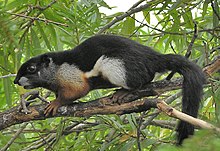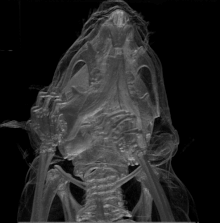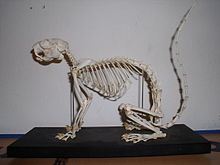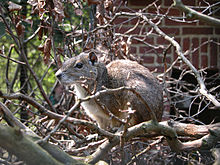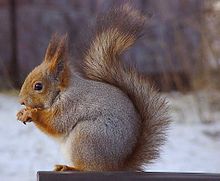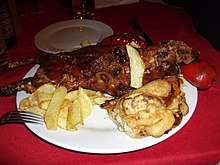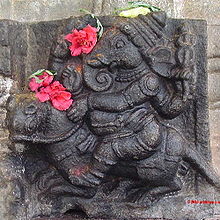Rodents
| Rodents | ||||||||||||
|---|---|---|---|---|---|---|---|---|---|---|---|---|

Wood mouse ( Apodemus sylvaticus ) |
||||||||||||
| Systematics | ||||||||||||
|
||||||||||||
| Scientific name | ||||||||||||
| Rodentia | ||||||||||||
| Bowdich , 1821 | ||||||||||||
| Submissions | ||||||||||||
|
The rodents (Rodentia) are an order of the mammals (Mammalia). With around 2500 to 2600 species, they make up around 40% of all mammalian species and are thus by far the most species-rich order of this group. At the same time they are the group with the most new descriptions within the mammals; between 2000 and 2017 at least 248 species were newly described or newly established within the order.
They are distributed almost worldwide and have colonized a large number of different habitats. Very few rodents are common as culture followers or pets , but these shape the image of the entire group. Many species, however, have hardly been researched and have a very limited range.
anatomy
The majority of rodents are short-legged, quadruped (moving on all fours), and relatively small. The most important common feature are the two enlarged, permanently growing incisor teeth in the upper and lower jaw, which are only surrounded by enamel on the outer side . Depending on the habitat and way of life, however, the most diverse forms have formed.
External physique
The size of the rodents varies between dwarf forms such as the African harvest mouse ( Mus minutoides ) and the Eurasian harvest mouse ( Micromys minutus ), which often weigh less than five grams, and the Capybara , the largest living rodent, which has a head trunk length of 100 to 130 centimeters and can reach a weight of 50 to 60 kilograms. Other large rodents include beavers , pakaranas, and pakas . Most rodents, however, are about the size of a mouse to rat and reach head-body lengths of about 8 to 30 centimeters.
Rodents usually have a thick coat of wool and outer hair. Only the tail is almost hairless in some species, and there is only one generally almost hairless species, the naked mole rat . The fur color is mostly inconspicuous, camouflaging colors, often gray or brown, in desert dwellers also yellowish. However, some tropical squirrels such as fine or giant squirrels also have colorful fur colors.
The majority of rodents have a tail , only in some large or subterranean species it is only rudimentary and does not exist externally. In some tree-dwelling species it is designed as a prehensile tail, in the beaver it is a flattened, hairless control organ. In many species, the tail can easily break off to facilitate the escape from predators; in such cases it partly grows back again.
At the tip of the snout , rodents usually have a short, rounded nose . The nasal mirror is only partially developed or is completely absent. The oral cavity is divided into two parts by a narrow opening, the front part contains the incisors, the rear part the molars. The toothless gap in between enables the lip to be drawn in . In addition, the hairy skin of the face continues behind the incisors ( inflexum pellitum ). Both prevent indigestible foreign bodies from entering the oral cavity while gnawing. The upper lip is often split so that the incisors are visible even when the mouth is closed. The tongue is short and compact with a blunt tip that never protrudes above the incisors. The taste papillae towards the tip of the tongue are small and thread-like, in porcupines they are sometimes enlarged and hard. Most species have three wall papillae at the root of the tongue.
Some species have large, to behind the ears reaching, lined with fur cheek pouches that can be everted for cleaning. In hamsters are the openings in the corners, with pocket rodents on the outer sides of the cheeks.
skull

The skull of the rodents is designed to strengthen the chewing apparatus like hardly any other group of mammals.
The eye socket is always open at the back and never surrounded by bones. The zygomatic process of the frontal bone , which lies behind the eye socket, is only partially developed or is completely absent. The croissants, where this extension is present, are an exception. The zygomatic bone also rarely forms a corresponding frontal bone process, so that the eye socket merges more or less completely into the temporal fossa . The tear hole is always in the edge of the eye socket.
In many species the infraorbital foramen is very large, in some it is as large as the eye socket, and part of the masseter runs through it. The zygomatic arch is developed differently and starts in front of the molar row.
The nose is large with few exceptions, and extends far forward. It is completely separated from the upper jaw by the large intermaxillary bone . The incisor holes in the palate are small and clearly defined. The palatine bone is short, in the case of sand graves even shorter than a molar. There is a large toothless gap between the incisors and molars .
The brain skull is small compared to the facial skull. The parietal bone is small, but the intermediate parietal bone is usually clearly defined. The tympanic bulla surrounding the middle ear is always present and generally large. In gerbils and jerboa, the additional mastoid bulla forms large, hemispherical swellings on the back of the skull. In these animals, the ear canal is tubular and runs upwards and backwards.
The body of the lower jaw is narrowed and rounded at the front and carries the lower incisors. The muscle process is small, the angular, lower rear part of the lower jaw large and pronounced. The joint head and the associated joint cavity of the temporomandibular joint are elongated backwards.
The arrangement of the zygomatic bone and the shape of the lower jaw are features used to classify families .
denture
The relatively uniform set of teeth of the rodents is their clearest morphological characteristic despite the diversity in body structure and lifestyle . Rodents originally had 22 teeth : four incisors, six front molars, four of them in the upper jaw and two in the lower jaw, and twelve rear molars. While the number of incisors has always remained the same, the number of molars has decreased in many groups . Canine teeth were never present and there is a large, toothless gap (diastema) between the incisors and molars .
Incisors

As incisors designated four enlarged incisors are the most characteristic feature of rodents. Even with the first known rodents, these were reduced to one pair each in the upper and lower jaw. The incisor teeth are rootless or have small, open tooth roots , have a tooth cavity that is open to the tooth socket and grow back for a lifetime. Due to the gnawing of hard food or other objects and the abrasion on the opposing teeth, they remain in a certain length constancy. The growth rate of the incisor teeth fluctuates between two and three millimeters per week in non-digging species and five millimeters in the pocket rats that dig with the incisor teeth . In hibernating animals, they continue to grow at a reduced rate. The front 30 to 60% of the incisor teeth are covered with tooth enamel , so that a sharp, chisel-shaped edge remains behind as the softer components wear out more quickly. The incisor teeth are regularly curved, those of the upper jaw more than those of the lower jaw.
In the absence of wear, the incisor teeth continue to grow and can pierce part of the skull. The lower incisor teeth grow forward and up out of the oral cavity and become completely unusable. The upper incisor teeth, on the other hand, curve around themselves and can grow spirally out of the oral cavity or, after exiting the oral cavity, pierce the lower and upper jaw from bottom to top and thus close the snout. This development is fatal, but wild rodents have survived for a long time.
The incisor teeth can be used for a wide variety of purposes, but mostly serve to break up hard-shelled food. The South American fish rats , whose fangs are sharpened, use them to kill their prey and some subterranean groups such as the pocket rats and the sand diggers to dig. In these species, the lips grow inward, separating the incisor teeth from the oral cavity. This ensures that no particles can get backwards during the gnawing activity. The power and sharpness of the incisor teeth is expressed, among other things, in the fact that beavers can fell a tree twelve centimeters in diameter in half an hour, and some species have reported that they can even break open cans with their teeth.
Molars
Many families have one per quadrant of the anterior molars (premolars); only a few croissants and sand diggers have two. In the mice , however, premolars are never formed.
Most species have three posterior molars per quadrant . A few species of the mice have only two, the Shaw-Mayer mouse ( Mayermys germani ) from New Guinea only one molar per half of the jaw - a total of only eight teeth and thus the fewest of all rodents. The total number of teeth in rodents is never more than 22, with the exception of the silver-gray earth auger ( Heliophobius argenteocinereus ), a species of sand digger that has 28 teeth due to secondary tooth multiplication.
In contrast to the incisor teeth, the molars have a limited growth in many species. In some groups, however, such as the stumpy-tailed squirrels , pocket rats , jumping hares , chinchillas and guinea pigs , the molars are also rootless and thus grow throughout their life.
A change of teeth does not usually take place in the incisor teeth ( monophyodontia ), only some guinea pigs (cavioidea) have milk teeth, which are, however, replaced by permanent ones before birth.
skeleton
The skeleton of the rodent is usually that of a quadruped, continuously moving mammal with a stocky build, short front legs, slightly longer hind legs, sole duct and long tail. However, other forms have also developed in adaptation to a wide variety of habitats.
The spine usually consists of seven cervical vertebrae , thirteen thoracic vertebrae , six lumbar vertebrae , three to four sacral vertebrae, and a variable number of caudal vertebrae . The shape of the vertebrae is different. In species that run or jump, the two transverse processes of the lumbar vertebrae are usually very long. The length of the tail spine varies between very short and over the length of the body.
The limbs are developed differently depending on the lifestyle. The shoulder blade is usually narrow and has a long acromion. A collarbone is present in most species, but incompletely developed or absent in some. The pelvis has large sit and pubic bones with a long and usually bony pubic symphysis .
The front legs show a distinct separation between the ulna and the radius . The front paws usually have five toes with normally developed toe bones . In some species, however, the big toe is receded or absent completely and cannot or can hardly be compared to the other toes.
The hind legs have a thighbone that fluctuates considerably in shape , but usually has three rolling hills at the joint head. Shin and fibula are fused together in jumping species. This provides greater stability for the upper ankle . The fibula does not form a joint with the calcaneus . The hind paws of the jerboa have greatly elongated metatarsals , in some species these are also fused together. The number of toes on the hind paws varies between three and five.
Internal anatomy
The jaws are provided with extremely strong masticatory muscles , the arrangement of which also plays an important role in the classification of these animals. The masseter is large and has the main force when gnawing. It is divided into three parts and extends from the underside of the zygomatic arch in front to the outside of the vertical part of the lower jaw ramus behind. As a result, it not only pulls the lower jaw up, but also forwards and thus ensures the gnawing movement. The temporal muscle is comparatively small compared to the masseter. The two- bellied digastric muscle has a clearly defined, central intermediate tendon . In many species the two anterior bellies of the muscle are united between the two branches of the lower jaw.
The digestive tract of rodents is geared towards a plant-based diet, despite the fact that there are also some omnivorous or predominantly carnivorous species. They are rectal fermenters, which means that they can break down cellulose in their appendix (caecum) using symbiotic bacteria . The colon (colon) is modified for this purpose and often has complex folds. Many species practice cecotrophy , which means that they excrete pre-digested intestinal contents (caecotrophs) and take them in again for final digestion. The stomach is built unilocular and easy in most species, some voles like the lemmings have - similar to ruminants - a glandular stomach loose section, which also takes place a pre-digestion.
The genitourinary system largely corresponds to that of the other higher mammals . The sexual organs are built very differently. A penis bone (baculum) is usually embedded in the penis , the testicles can either be in the abdominal cavity or outside, with some species there is a seasonal testicle descent . The females always have a pair of uterus (uterus duplex).
The brain is small and the mostly smooth ( lissencephalic ) hemispheres of the cerebrum do not extend far back and therefore do not protrude beyond the cerebellum .
Diversity in physique
As an adaptation to the most varied of habitats and the realization of different ecological niches , the rodents have developed a remarkable diversity in their physique. Two groups, the flying squirrels and the thorntail squirrels , have independently formed a sliding membrane between the limbs, which they can use to glide between trees. Some rodents have adapted to an underground burrowing way of life with a plump, cylindrical body, short limbs, reduced or receding eyes and partially enlarged grave hands. These include pocket rats , blind mice and mole rats from the Spalacidae group , crested rats and sand graves . In some species there was an elongation of the hind legs and thus a hopping mode of locomotion, such as in the kangaroo rats , the jerboa and the jumping hare . The agoutis and pampas hares of America developed elongated limbs with hoof-like toes and are, in a sense, the ecological equivalent of small ungulates and hares .
Numerous species have adapted independently of one another to an aquatic (in water) way of life by means of streamlined bodies, water-repellent fur and sometimes webbed feet between the toes and oar tails. Examples are the beaver , the muskrat , the beaver rat or nutria, the South American fish rats or the Australian swimming rats . To ward off predators, several groups of rodents such as porcupines , tree prickers or, in some cases , spiny rats have a prickly coat. Finally, a large part of the species is similar in its compact body with the rather short legs and the short neck to rats or mice , including many mice , the dormice and other groups.
During the Miocene , Ceratogaulus was the only horned rodent representative. The function of the horns is unclear, with suspicions being suggested that they may have played a role in recruiting, defending, or as another digging tool. The fact that the horns occurred in both sexes speaks against a role in partner choice.
distribution

Rodents have reached almost worldwide distribution, they were originally only missing in Antarctica and on remote islands - such as New Zealand and most of the Pacific islands. Besides the bats, they are the only taxon of the placenta that has colonized the Australian continent without human influence , namely in the form of some old world mice (Murinae). Although there are a number of aquatic species, the rodents have not conquered the seas as a habitat.
Some species, such as the house mouse , the house rat or the brown rat, have achieved worldwide distribution as cultural followers , which is why rodents can be found virtually everywhere today where there are humans.
Way of life
Rodents have colonized almost all habitats on earth, they can be found in deserts as well as in tropical rainforests , in high mountains and in polar regions . Also because of the diverse habitats and the most varied of body shapes, very few general statements can be made about the rodents' way of life.
Social behavior and activity times
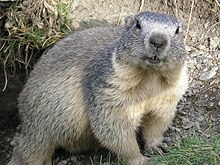
The activity times of rodents vary depending on the species and habitat, but the majority are crepuscular or nocturnal. In some groups, for example the squirrels, however, mainly diurnal animals can be found. Some inhabitants of colder regions have a pronounced hibernation (well-known examples from Europe are dormice and marmots ), others such as the lemmings are also active during winter. In return, some inhabitants of tropical regions fall into a heat or drought paralyze during the hot or dry season , e.g. B. fat mice .
With regard to social behavior, all forms can be found within rodents, from strictly solitary species that avoid any contact with conspecifics outside of the mating season, through species that live in pairs to species that have developed a well-developed social system. The rodents that live in large underground burrows, such as viscachas or prairie dogs, are particularly known for this. Unique among mammals is the eusocial way of life of some sand graves such as the naked mole rat or the gray mole rat : Similar to some insects, a single female, the “queen”, is fertile in a colony and mates with several males, while the other animals are sterile workers perform the activities necessary to supply the group.
nutrition

Rodents are predominantly, but not exclusively, herbivores . Depending on the species, habitat or season, all parts of plants are consumed: grasses, leaves, fruits, seeds and nuts, but also twigs, bark, roots and tubers. One of the main reasons for the evolutionary success of rodents is presumably the fact that, like hardly any other group of mammals, they combine herbivory with small body size - most other herbivorous mammals are significantly larger.
There are numerous purely herbivorous species, but some species are partially omnivorous and consume insects, worms and other invertebrates at least as complementary food, but also bird eggs and small vertebrates, including squirrels, dormice and some mice or the sand diggers .
However, there are also a few species that feed primarily or almost exclusively on insects and other small animals. Examples of this are some genera of the New World mice , such as the grasshopper mice ( Onychomys , named after their main food), the grave mice ( Oxymycterus ) or the group of fish rats (Ichthyomyini), which feed on aquatic insects, crabs and fish. The African water rat and the Australian swimming rat (Hydromyini), which prefer to eat fish, or representatives of the Deomyinae such as the Congo wood mouse or the brush hair mice , which mainly feed on insects, are also included.
Reproduction and development
Rodents belong to the group of placentates or higher mammals (Eutheria), as such their reproduction is characterized by the placenta and the trophoblast (the outer cell layer of the early embryo ), which represents an immunological barrier and, compared to the marsupial mammals, the fetuses grow longer made possible in the womb. Apart from that, there is hardly anything general that can be said about the reproduction of this group of animals.
Many species, such as the mouse relatives , are characterized by an extremely high fertility ( r-strategy ). The female can give birth to offspring several times a year, the gestation period is short and the litter size is high. The newborns are nestled , often hairless and helpless, but grow very quickly and reach sexual maturity within weeks or months. Some hamster species have the shortest gestation period of all placenta animals at just 16 days and are sexually mature at seven to eight weeks. Multi- teat mice have up to 24 teats and naked mole rats can carry up to 27 newborns per litter.
On the other hand, there are also a number of groups in which it is practically the other way round, such as the guinea pig relatives . Their gestation period is comparatively long (for example up to 280 days for the Pakarana ), there are only a few young animals per litter and the stage of development at birth is quite high ( K strategy ). The offspring of larger species are born with their fur and eyes open; many young animals can walk after a few hours and are independent of their mother a short time later.
Enemies and life expectancy
Rodents have numerous predators and, due to their abundance, are the basic foodstuff for many predators. Many mammals , birds , reptiles and amphibians , but also invertebrates - such as some tarantulas or fishing horrors - hunt them. The smaller representatives in particular have hardly any active defense strategies, instead they rely on caution, camouflage, concealment or flight - some species also benefit from their well-developed social behavior. Diseases and parasites are further threats to rodents. For many species, humans are the greatest threat. While the targeted hunt of rodents regarded as " pests " often does not bring the desired success, the destruction of the habitat and the introduction of neozoa have led to the extermination of some species, several others have already been pushed to the brink of extinction (see below for details).
Life expectancy is very variable. Even without the threat of the omnipresent predators, many species, such as mice , only reach a maximum age of one to two years. But there are also longer-lived rodents. A maximum age of 27 years is known for the common porcupine , the age record is held - as far as known - by a naked mole rat with an estimated 28 years.
Systematics and tribal history
External system
The rodents are usually grouped together as the order Rodentia with the hare-like (order Lagomorpha), their presumed sister group , as Glires . Within the Euarchontoglires, the Glires are compared to the orders of the shrews , giant gliders and primates summarized as Euarchonta . A graphical representation of the possible family relationships looks like this:
| Euarchontoglires |
|
||||||||||||||||||||||||
|
|
The relationship with the hare-like is well founded morphologically , and they were placed as a subgroup to the rodents (order Glires) in Carl von Linné's Systema Naturae as early as 1735 . Doubts about this relationship that arose at the beginning of the 20th century, which were also reflected in a split into two orders, were largely dispelled by recent molecular genetic studies. According to this, rodents and rabbits probably separated in the Middle Upper Cretaceous .
The classification in the Euarchontoglires is still young and is so far only supported by molecular genetics. Both the common ancestry and the sister group relationships within the Euarchontoglires are still uncertain.
Some mammals are referred to as "mice" or "rats" because of external similarities, but they do not belong to the group of rodents. These include the shrews from the order of the insect eater , the pouch mice and opossum rats from the group of the marsupial mammals and others. The bats are not rodents either.
Internal system

The rodents are by far the largest order of mammals. After their species richness in the mid-20th century by the uncritical use of biological Artbegriffs was veiled, the recognition of new species is steadily in recent years continued:
- 1980: 1591 species
- 1982: 1719 species or about 41.2 percent of all mammals
- 1986: 1738 species
- 1993: 2015 species or about 43.5 percent of all mammals
- 2005: 2277 species or about 42.0 percent of all mammals and 481 genera
The division of recent rodents into five sub-orders with 34 families carried out here largely follows Carleton & Musser (2005).
Order rodents (Rodentia)
-
Suborder squirrel relatives (Sciuromorpha)
- The dormice or sleeper (Gliridae) are outwardly Croissant or mouse-like animals of the Old World, including but not limited to the dormouse and the dormouse .
- Superfamily croissants (Sciuroidea)
- The stubby- tailed squirrel ( Aplodontia rufa , Aplodontiidae) is a primitive rodent of western North America.
- The squirrels (Sciuridae) are a species-rich, diverse and almost worldwide group. These include, for example, squirrels , flying squirrels , ground squirrels and marmots .
-
Subordination beaver relatives (Castorimorpha)
- The beavers (Castoridae) are large, aquatic rodents with two species found in North America and Eurasia.
- The pocket rodents (Geomyoidea) are named after their external cheek pouches and live in North and Central America.
- The pocket rats (Geomyidae) are mole-like, burrowing rodents.
- The pocket mice (Heteromyidae) include not only some mouse-like species, but also the jerboa-like kangaroo mice and kangaroo rats .

-
Subordination thorntail squirrel relatives (Anomaluromorpha)
- The jumping hare ( Pedetes capensis , Pedetidae) is a kangaroo-like rodent from Africa.
- The thorntail squirrels (Anomaluridae) are also native to Africa. Most species have a flight membrane.
-
Suborder mouse relatives (Myomorpha)
- The jerboa (Dipodidae), hippopotamus (Zapodidae) and birch mice (Sminthidae) are characterized by elongated hind legs and are found in the Old World and North America.
- Superfamily Mice (Muroidea)
- The stachelbilche (Platacanthomyidae) live in tropical Asia and externally resemble the dormouse.
- The Spalacidae consisting of blind mice and mole rats as well as root and mole rats are predominantly underground animals.
- Eumuroida
- The mouse hamsters (Calomyscidae) are a species-poor group of hamster-like animals from West and Central Asia.
- The Nesomyidae are mouse-like animals from Madagascar ( Madagascar rats ) and Africa (e.g. tree mice ).
- The Hustler (Cricetidae) summarize the hamsters , voles and New world together. The species-rich group lives in America and Eurasia.
- The long-tailed mice (Muridae) are a species-rich group originally found in Eurasia, Africa and Australia. These include old world mice (such as mice and rats ), but also gerbils and other groups.
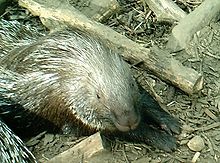

-
Suborder porcupine relatives (Hystricomorpha)
- The Laotian rock rat ( Laonastes aenigmamus , Diatomyidae ( incertae sedis )) was only discovered in 2005. Their systematic position is still unclear.
- Comb finger-like (Ctenodactylomorphi)
- The comb fingers or gundis (Ctenodactylidae) live in arid regions of Africa and have a certain resemblance to the guinea pigs.
- Hystricognathi
- The porcupines (Hystricidae) are animals from Eurasia and Africa, characterized by long spines.
- Partial order Phiomorpha
- The sand graves (Bathyergidae) like the naked mole rat are underground burrowing animals from Africa.
- Superfamily Thryonomyoidea
- The guinea pig relatives (part order Caviomorpha) live on the American double continent.
- Superfamily tree spikes (Erethizontoidea)
- The tree prickers (Erethizontidae) including the bristle tree prickler resemble the old world porcupines, but are predominantly tree dwellers.
- Superfamily guinea pigs (Cavioidea)
- The pakas (Cuniculidae) are two species of relatively large, stocky forest dwellers.
- The guinea pigs (Caviidae) also include pampas hares and the capybara .
- Agoutis and Acouchis (Dasyproctidae) are large, rather long-legged animals.
- Superfamily chinchillas (Chinchilloidea)
- The Pakarana ( Dinomys branicki , Dinomyidae ) is a large, shy animal from northern South America.
- The chinchillas (Chinchillidae) also include rabbit mice and viscachas .
- Superfamily Trugrattenverbindungen (Octodontoidea)
- The chinchilla rats (Abrocomidae) inhabit mountain regions in the Andes. Their fur is similar to that of chinchillas.
- The Trug rats (Octodontidae) live in southern South America. This includes the degu .
- The comb rats (Ctenomyidae) form a group of rodents living in underground burrows.
- unnamed taxon (NN)
- The quill rats (Echimyidae) are characterized by their mostly bristly or prickly fur and are also found on the West Indies.
- The beaver rat or nutria ( Myocastor coypus , Myocastoridae) is now also at home in Europe as a captive refugee.
- The tree rats or hutias (Capromyidae) live on the West Indies. Many species are critically endangered or already extinct.
- The giant hatias (Heptaxodontidae) were some huge animals living on the West Indies, all of which were extinct. Their systematic position is still unclear.
- Superfamily tree spikes (Erethizontoidea)
The rodents form a well-founded family group due to some derived, morphological characteristics ( synapomorphies ) and molecular genetic results . A graphic representation of the possible phylogenetic relationships according to Heritage and colleagues (2016) looks like this:
| Rodents cladogram | |||||||||||||||||||||||||||||||||||||||||||||||||||||||||||||||
|---|---|---|---|---|---|---|---|---|---|---|---|---|---|---|---|---|---|---|---|---|---|---|---|---|---|---|---|---|---|---|---|---|---|---|---|---|---|---|---|---|---|---|---|---|---|---|---|---|---|---|---|---|---|---|---|---|---|---|---|---|---|---|---|
|
Among the croissant relatives, stubby-tailed croissants and croissants have long been a well-documented relatives. The suspected relationship with the dormouse has recently received increasing support. The relationship between beavers and pocket rodents and thus the grouping as beaver relatives is now quite certain. The mouse relatives form a well-documented relationship group.
The relationships within the porcupine relatives are now quite well documented. Accordingly, the Kammfinger form the sister group of all other families. The Phiomorpha and the guinea pig relatives also receive good support as kin groups. Only the sister group relationship between Phiomorpha, guinea pig relatives and porcupines is not yet clear.
Traditional classification features
Traditionally, two morphological features are used to classify families.
A distinction is made between two types of the lower jaw:
- sciurognath : The body of the lower jaw and the outside of the branch of the lower jaw lie on an almost straight line.
- hystricognath : the body of the mandible and the outside of the branch of the mandible form an angle.
A distinction is made between four types of masticatory muscles:
- protrogomorph : The snout is unchanged in the original expression. The masseter muscle is small and only attaches to the underside of the zygomatic arch. This expression is found in extinct families from the Paleocene and in the stump-tailed squirrels . In the case of sand graves , this feature has regressed from the hystricomorphic expression .
- sciuromorph : The underside of the zygomatic arch inclines in front to a vertical surface. The lateral masseter is placed between the eye and the snout and moves the lower jaw forward while gnawing. The superficial masseter attaches along the zygomatic arch and the medial masseter attaches to the underside of the zygomatic arch. It is short and only serves to close the jaw. This expression is found in most squirrels, beavers , pocket rodents and the extinct family Eomyidae.
- hystricomorphic : The medial masseter is enlarged, runs through the also enlarged infraorbital foramen and is responsible for gnawing. The superficial masseter attaches to the front edge of the zygomatic arch, while the lateral masseter attaches along the zygomatic arch. Both are only used to close the jaw. This expression can be found in the porcupine relatives , the thorn- tailed squirrels and the spring hare , the jerboa , some fossil mice and in the African dormouse .
- Myomorphic : The underside of the zygomatic bone inclines, as in the sciuromorphic form, to a vertical surface in front, the lateral masseter attaches between the eye and muzzle and the superficial masseter along the zygomatic arch. Both start far back on the lower jaw and the former crosses the enlarged medial masseter . This runs under the zygomatic arch, runs through the enlarged foramen infraorbitale as in the case of the hystricomorphic form and leads through the eye socket to the anterior upper jaw. This expression enables the most effective gnawing and is found in the mice as well as convergent in some dormice (sometimes referred to here as pseudomyomorphic ). A similar expression may also be found in the extinct Cedromurinae .
History of the system
Main article: History of the rodent classification
Already Carl von Linné in his Systema Naturae from 1735 on originally summarized all rodents including the rabbit-like in the order Glires . In addition, this order contained shrews , desmanes , opossums , rhinos , bats and the finger animal at times also unrelated mammal species. The name Rodentia for the order of rodents including the hare-like comes from 1821. According to the different characteristics of their masticatory muscles , these were divided into Sciuromorpha ("squirrel-like"), Myomorpha ("mouse-like"), hystrichomorpha ("porcupine-like") and lagomorpha ("rabbit-like"). The first three groups, the rodents in today's sense, were summarized in 1876 as Simplicidentata and compared to the rabbit-like (Duplicidentata). According to the structure of their lower jaw, however, the rodents in today's sense were divided into the Sciurognathi and the Hystricognathi in 1899. In addition to the three-part division into Sciuromorpha, Myomorpha and Hystricomorpha, this division is widespread to this day. In 1912 it was first suspected that rodents and rabbits were not closely related, and the two groups were henceforth listed as separate orders.
In the early 1990s, the provocative publication Is the Guinea-Pig a Rodent? (“Is the guinea pig a rodent?”) Put forward the theory in the journal Nature that the guinea pig relatives are not related to the other rodents but split off at an earlier point in time than other mammalian orders. Other studies of morphological and molecular data, however, confirmed the monophyly (the common ancestry of all species from a common ancestor) of rodents, which is now largely regarded as a consensus.
Tribal history
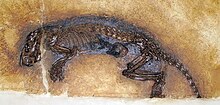

The first finds that can undoubtedly be assigned to rodents come from the Upper Paleocene , but the group is likely to have originated in the Cretaceous Period . The Zalambdalestidae , a group living in the Upper Cretaceous in Asia, are sometimes cited as Mesozoic forerunners . These relatively large for Mesozoic Mammals had a the elephant-shrews comparable physique and reported in the construction of the enlarged lower incisors similarities to the rodents. Whether they actually represent the ancestors of rodents or glires (the common taxon of rodents and rabbits ) is a matter of dispute.
The Eurymylidae family lived in Asia in the lower Palaeocene and, like the rodents of today, only had two enlarged incisors per jaw, but differed from these in the details of the structure of the teeth. Today the Eurymylidae are classified more as a sister group of rodents and not as its basic representative. The same applies to the Alagomyidae , which also lived in Asia and North America in the Paleocene.
The oldest known representatives of rodents are the Ischyromyidae (possibly together with the Paramyidae), which were widespread in North America in the late Paleocene and which had a somewhat more original set of teeth with a penultimate premolar and generally low-crowned molars. The division into the five subordinates was already completed towards the end of the Cretaceous period . In the Eocene the rodents spread to Eurasia and Africa , and towards the end of this epoch there was an almost explosive radiation and many of today's groups emerged. Among other things, croissants, beavers , thorn-tailed squirrels , mice , comb fingers and dormice from this period or at the latest from the early Oligocene are documented.
A group of rodents, which today are grouped together as guinea pig relatives , reached South America in the early Oligocene (around 31 million years ago) - probably swimming from Africa on driftwood across the then much narrower Atlantic . At that time, as during most of the Cenozoic , South America was isolated from the rest of the continents, so that its own fauna could develop, comparable to the situation in Australia . There were only a few groups of mammals there (the marsupial mammals , the extinct South American ungulates and the secondary animals ), which is why the guinea pig relatives were able to occupy some ecological niches that are untypical for rodents and are only found in this form in this group. Some grass-eating species are, so to speak, the ecological equivalent of the even- toed ungulates , and gigantic forms have also developed. Even today, the Capybara, the largest rodent, belongs to this group, extinct forms such as Phoberomys even reached the size of hippos .
It is noteworthy that the rodents were the only group of land-bound placenta animals able to colonize the Australian continent before the global spread of humans . This immigration happened in waves five to ten million years ago. Today there are a number of genera endemic to this continent, including the swimming rats , the Australian rabbit rats and the bunny rats . At a later point in time the rats with several representatives also reached Australia.
Rodents and humans
Rodents as farm animals
A number of rodent species are kept by humans as livestock , that is, to gain an economic purpose. The most important purposes are the enjoyment of their meat, the use of the fur and animal experiments.
The consumption of the meat of rodents is unusual in the Central European cultural area today, even if these animals were also eaten in earlier times, especially in emergency situations. In other regions of the world, however, they are eaten, and some types are even considered a delicacy. Well-known examples are the house guinea pigs , which are bred and eaten millions of times in South America - especially in Peru -, the cane rats , which are kept in some West African countries such as Ghana and whose breeding is propagated by the Food and Agriculture Organization of the UN (FAO), or the dormouse , which was considered a delicacy in ancient Rome and was fattened in specially created glirariums. In addition, rodents are not only bred for human consumption, but are also used as food, for example for lizards and snakes and other animals kept in zoos or private terrariums .
Some rodents are hunted or bred for their fur . The best known representatives in this country are the real chinchillas , the muskrat and the beaver rat or nutria; however, various species serve as fur suppliers worldwide.
Animal experiments represent a significant area of the use of rodents . These animals are mainly used because they are small, easy to breed and keep, and reproduce very quickly. Over 80%, sometimes even over 90%, of the animals used are rodents, above all colored mice , followed by colored rats and house guinea pigs. The controversy over the real benefits of these practices is extremely intense. The use of rodents in space travel can also be counted as animal experiments . House mice and house guinea pigs were flown into space for the first time on board the Soviet spaceship Vostok 3 A in March 1961, and brown rats and pocket mice were added later.
Rodents as pets
Numerous rodents are also kept as pets or petting animals, that is, for joy and personal affection and not for a direct economic benefit. The reasons for keeping rodents include their small body size and the associated low keeping costs. However, many species are only conditionally suitable as pets due to their nocturnal way of life and their unwillingness to be touched, and for many species that live in large groups or need a lot of exercise, it is hardly possible to keep them appropriately . Among the species that are kept as pets include guinea pigs , gold , minke and other hamsters , home , racing , jumping and other mice , Norway rats , degus , chinchillas , slide , strip and other squirrels, several Dormouse species and more.
Rodents as "pests" and a danger to humans

Around 200 to 300 species are considered to be agricultural or food pests. Some of them stay in the areas used for food production , where they eat the crops themselves or, through their subterranean way of life, cause damage to the roots and tubers of the plants. Often humans are the main cause of this, as they massively intervene in the natural habitat of animals. The conversion of habitats into agricultural areas and the reduction in the food supply force many species to find new sources of food. In Indonesia, for example, 17% of the rice harvest is lost to rodents. These are then in competition with the economic interests and initiate the persecution. The hemerophilic species (culture followers), for example mice and rats , also look for food directly in the places where food is stored. In addition, the gnawing activity often leads to further material damage, for example to insulation materials, electricity and water pipes.
In addition to the material damage that rodents cause, some species are also known as carriers of disease and thus pose a threat to humans. Infections can occur in a wide variety of ways: Bites can transmit pasteurellosis and rabies , among other things , although rodents are less likely to carry the rabies virus are affected than other mammalian groups. Their excrement can lead to the transmission of salmonellosis and leptospirosis ( Weil's disease ) as well as hemorrhagic fever ( hantaviruses ); through the consumption of rodents, which, as mentioned above, occurs quite frequently in non-European countries, to trichinosis . The best known are probably the diseases that are transmitted by fleas that parasitize on these animals , such as the murine typhus and the plague , which killed millions of people in several pandemics .
threat
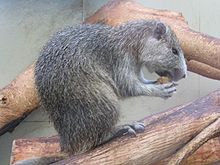
The wide distribution of some species following culture should not hide the fact that many rodent species have a small distribution area and are endangered or threatened species. The reasons for this include the targeted tracking of animals considered pests (for example prairie dogs ), hunting for the meat or the fur (as with the short-tailed chinchilla ), the destruction of the habitat, which mainly affects forest-dwelling species and the displacement by introduced or immigrated neozoa .
The IUCN lists 38 rodent species as extinct in 2019, besides some Australian species, these are mainly species that were endemic to islands . These include all giant hatias , some representatives of the tree and barbed rats of the Caribbean islands, the Caribbean giant rice rats , a South American tree spike species , the Canary giant rat , as well as from Australia the white-footed rabbit rat , the little bunny rat and several types of Australian jumping mice . Furthermore, according to the IUCN, 53 species are critically endangered, 146 are endangered and 134 are vulnerable , for 406 species there is too little data, which is why they are listed as ( data deficient ).
Rodents in culture
Very few species of rodents play a role in human culture. What is striking, however, is that, contrary to their reputation as pests, they often play positive roles. They are - presumably due to their adaptability - often portrayed as smart and shrewd, who successfully defend themselves against larger, often stupid opponents.
Mice and rats are certainly the most common rodents depicted in this way. In Chinese astrology , people who were born in the year of the rat or mouse (鼠, shu) are considered aggressive, but also intelligent and self-confident. In India , too , rats are a symbol of intelligence and strength, for example the god Ganesha is often depicted riding a rat or mouse. In the Western culture, rats have a significantly more negative population, they are often considered to be malignant. The widespread disgust or fear of rats is brought up in Die Rättin by Günter Grass or in 1984 by George Orwell .
Mice, on the other hand, embody the "sweet", benign character. Accordingly, mice with positive connotations appear frequently, especially in children's literature and cartoons , for example Walt Disney's Mickey Mouse or the character in the show with the mouse . The stereotypical battle between mice and cats , in which the cats are usually defeated, is also often depicted, for example in cartoon series such as Tom and Jerry or Speedy Gonzales . Mice can be found in an allegorical way, for example, in Franz Kafka's Josefine, the singer or Das Volk der Mäuse or in the comic Mouse - The Story of a Survivor, which deals with the Nazi era .
The activities or characteristics of some other rodents have become proverbial, for example the long hibernation of marmots or dormice . The hamsters ' collecting activity is the inspiration for an exaggerated need for hoarding , and the beavers' building activity is regarded as the epitome of hard work .
literature
- Michael D. Carleton, Guy G. Musser: Order Rodentia . In: Don E. Wilson, DeeAnn M. Reeder (Eds.): Mammal Species of the World . 3rd edition. The Johns Hopkins University Press, Baltimore 2005, pp. 745-752, ISBN 0-8018-8221-4 .
- Thomas S. Kemp: The Origin & Evolution of Mammals . Oxford University Press, Oxford 2005, 331 pages, ISBN 0-19-850761-5 .
- Wolfgang Maier: Rodentia, rodents . In: Wilfried Westheide, Reinhard Rieger (Ed.): Special Zoology. Part 2: vertebrates or skulls . Spectrum Akademischer Verlag, Heidelberg - Berlin 2004, 712 pages, ISBN 3-8274-0307-3 .
- Grant Singleton, Christopher R. Dickman, D. Michael Stoddart: Nager. In: David W. Macdonald (ed.): The great encyclopedia of mammals. Könemann Verlag, Königswinter 2004, pp. 578-587, ISBN 3-8331-1006-6 (German translation of the original edition from 2001).
- Ronald M. Nowak: Walker's Mammals of the World . 6th edition. Johns Hopkins University Press, Baltimore 1999, ISBN 0-8018-5789-9 (English).
- Malcolm C. McKenna, Susan K. Bell: Classification of Mammals: Above the Species Level . Columbia University Press, New York 1997, XII + 631 pages, ISBN 0-231-11013-8 .
- Hans-Albrecht Freye: The rodents. In: Bernhard Grzimek et al. (Ed.): Grzimeks animal life . Vol. 11. Mammals 2. Kindler Verlag, Zurich 1969, pp. 204–211.
- Richard Lydekker: Rodentia. In: The Encyclopædia Britannica . 11th edition. 13. University of Cambridge, New York 1911, pp. 437-446.
Web links
Individual evidence
- ↑ a b Numbers from: Thomas E. Lacher, William J. Murphy, Jordan Rogan, Andrew T. Smith, Nathan S. Upham: Evolution, Phylogeny, Ecology, and Conservation of the Clade Glires: Lagomorpha and Rodentia. In: Don E. Wilson, TE Lacher, Jr., Russell A. Mittermeier (Eds.): Handbook of the Mammals of the World: Lagomorphs and Rodents 1. (HMW, Volume 6) Lynx Edicions, Barcelona 2016, p. 15 , ISBN 978-84-941892-3-4 .
- ^ A b Guillermo D'Elía, Pierre-Henri Fabre, Enrique P. Lessa: Rodent systematics in an age of discovery: recent advances and prospects. Journal of Mammalogy 100 (3), 2019; Pp. 852-871. doi : 10.1093 / jmammal / gyy179
- ↑ All figures from Nowak (1999).
- ↑ R. Buffenstein, JU Jarvis: The naked mole rat-a new record for the oldest living rodent. In: Science of aging knowledge environment: SAGE KE. Volume 2002, Number 21, May 2002, pp. Pe7, ISSN 1539-6150 . doi : 10.1126 / sageke.2002.21.pe7 . PMID 14602989 .
- ↑ Toni I. Gossmann, Achchuthan Shanmugasundram, Stefan Börno, John J. Welch, Bernd Timmermann, Markus Ralser: Ice-Age Climate Adaptations Trap the Alpine Marmot in a State of Low Genetic Diversity. Current Biology, VOLUME 29, ISSUE 10, P1712-1720.E7, May, 2019, DOI: 10.1016 / j.cub.2019.04.020
- ^ Gordon Barclay Corbet, John Edwards Hill: A World List of Mammalian Species . Comstock, London 1980, VIII + 226 pages.
- ↑ James H. Honacki, Kenneth E. Kinman, James W. Koeppl (Eds.): Mammal Species of the World . A Taxonomic and Geographic Reference. Allen Press, Inc. and The Association of Systematics Collections, Lawrence, Kansas 1982, IX + 694 pages, ISBN 0-942924-00-2 .
- ^ Gordon Barclay Corbet, John Edwards Hill: A World List of Mammalian Species . 2nd edition. Facts on File Publications, New York 1986, 254 pages, ISBN 0-565-00988-5 .
- ↑ Don E. Wilson, DeeAnn M. Reeder (Ed.): Mammal Species of the World . A Taxonomic and Geographic Reference. 2nd edition. Smithsonian Institution Press, Washington, DC 1993, XVIII + 1,207 pages, ISBN 1-56098-217-9 .
- ↑ Don E. Wilson, DeeAnn M. Reeder (Ed.): Mammal Species of the World . A Taxonomic and Geographic Reference. 3rd edition. The Johns Hopkins University Press, Baltimore 2005, XXXV + XVII + 2142 pages, ISBN 0-8018-8221-4 .
- ↑ Michael D. Carleton, Guy G. Musser: Rodentia. In: Don E. Wilson, DeeAnn M. Reeder (Eds.): Mammal Species of the World: A Taxonomic and Geographic Reference . 3. Edition. The Johns Hopkins University Press, Baltimore 2005, pp. 745-752, ISBN 0-8018-8221-4 (English).
- ↑ a b Heritage S. et al. 2016. Ancient phylogenetic divergence of the enigmatic African rodent Zenkerella and the origin of anomalurid gliding. PeerJ 4: e2320; doi: 10.7717 / peerj.2320
- ↑ Sean D. Bell: Aplodontid, Sciurid, Castorid, Zapodid and Geomyoid Rodents of the Rodent Hill Locality, Cypress Hills Formation, Southwest Saskatchewan. Saskatoon, December 2004 ( PDF ( Memento from January 20, 2012 in the Internet Archive ); 6.092 kB).
- ^ Siv Hamre Paus: Reconstruction of the skull of Ailuravus macrurus (Rodentia) from the Eocene of Messel, Germany. Kaupia 11, 2003, pp. 123-152
- ↑ Animal experiment statistics from Austria ( Memento from March 25, 2016 in the Internet Archive ), [Switzerland] and ( page no longer available , search in web archives )
- ↑ Maier (2004), p. 532.
- ↑ Figures from The IUCN Red List of Threatened Species , accessed January 14, 2020.
